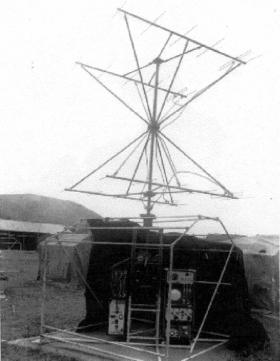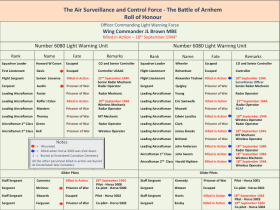Airborne Operations. 38 Group - RAF specialist enablers
With the increasing use of paratroops and glider borne forces, the Royal Air Force developed the use of specialist enablers to act as the eyes and eyes of the Air force on the ground. To this end Airfield Activation teams saw action where ever austere landing strips needed to be established. The first use of British Paratroops was Operation COLOSSUS in February 1941, where a small force was sent to attack an aqueduct in Italy. Another airborne assault was made against a Bruneval in France; two others were on OPERATION TORCH in Tunisia and the allied invasion of Italy. The Tunisian landing in 1943 proved a complete success and even more complete was operation mounted in support of the Normandy landings, this was due to the successful resupply drops and total air superiority. One problem that was encountered in all of the airborne operations was the correlation and control of Close Air Support missions and the possible incurrence of ‘friendly fire’ deaths. However, on MARKET GARDEN, Montgomery’s bold plan of capturing the vital bridges over the Dutch rivers in 1944, the plan was to deploy two highly secret radar units so that CAS could be given to the lightly equipped airborne units.
Light Warning Units/ Air Ministry Experimental Station
Detached to the 4th Parachute Battalion RAF engineers and radar controllers landed in Arnhem on the 18th Sep 1944. There task was to control Close Air Support missions by the Allied aircraft, a task that if all had gone to plan could have changed the course of history. The detachment of 25 RAF personnel were part of 6080 AND 6341 Light Warning Units (LWUs), which had been transferred from No 60 (signals) Gp to No 38 Gp and attached to HQ 1st British Airborne Corps in the days leading up to Operation Market Garden. The two Units were each equipped with the TOP SECRET Air Ministry Experimental Station (AMES) which could be transported in two gliders. The plan was to deploy the systems on the second phase of gliders reaching Holland on the 17thand 18th Sep. The first was planned to land at Groesbeek in order to support the Brigade HQ, however, German strafed the aircraft and the glider landed at Nijmegen mortally wounding the Units CO. Nevertheless the 4 Horsa gliders containing the LWUs; gliders No 5000-5003 took off from RAF Harwell in Oxfordshire just after 1200hrs on the 18th. As the aircraft began their approach to the landing zones, No 5000 had to crash land when its tug aircraft was hit by flak and crashed. The glider landed near the town of Zetten after which the surviving crew destroyed the equipment and despite having little infantry training, made there way to fight at Arnhem. No5003 was hit by the same concentration of flack and crashed, killing 6 members of 6341 LWU plus the pilots. No’s 5001 and 5002 landed as planned at LZ ‘Z’, Wolfheze wood. 7 miles west of Arnhem but the crews soon realised that without all of the equipment, the AMES would not function.(the station needed a receiver and transmitter to function and both transmitters were loaded onto 5000 and 5003). As a solution was being cobbled together the two gliders were destroyed by heavy German fire on the LZ. The crews then had no choice but to accompany the infantry-trained glider pilots into battle.
The loss of the LWUs had a huge impact on the battle. Despite having Air Supremacy at the time of the Operation, Allied Commanders were worried about the friendly fire incidents. They had encountered in previous airborne landings as it was difficult for aircrew to distinguish between the fighting forces and the line of advance. Therefore throughout MARKET GARDEN, they forbade fighter AC from attacking targets of opportunity for fear of killing ‘friendly forces’. Instead they ordered that airborne fire support should be requested by ground forces via the HQ and then the aircraft could be controlled by the LWUs. Unfortunately, the poor radio coverage that had plagued the Operation, added to the disastrous insertion of the LWUs meant that the Luftwaffe owned the air above Arnhem and were able to deliver firepower onto an already beleaguered 1st AB Div. The lightly armed British troops rely on the Close Air Support they so desperately needed to hold back the enemy heavy armour and thus the battle turned.
At the end of the week long battle, the remains of the now exhausted 1st Airborne Division were under siege in the Oosterbeek area and with no signs of respite and little or no ammunition, decided to undertake a risky night time crossing of the Rhine in order to reach the British lines. Only four members of the LWUs, including a US Army 1ST Lt, made this crossing and escaped. Of the 25 personnel of 6080 and 6341 LWUs that were flown into Holland, 10 were killed and 11 captured.
The last major airborne operation of the war in Europe was OPERATION VARSITY, the crossing of the Rhine in March 1945. This operation was deemed a complete success in the use of airpower, ground support elements and CAS. The marking of DZ and landing strips proved to be extremely accurate thus enabling the Airborne forces to achieve all allocated targets without major loss.
With information supplied by Geordie S






Latest Comments
There are currently no comments for this content.
Add Comment
In order to add comments you must be registered with ParaData.
If you are currently a ParaData member please login.
If you are not currently a ParaData member but wish to get involved please register.